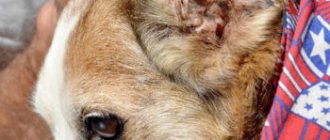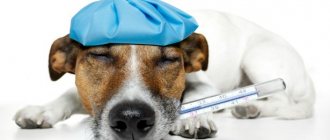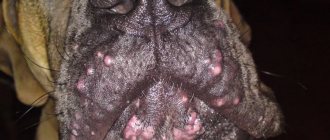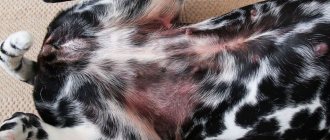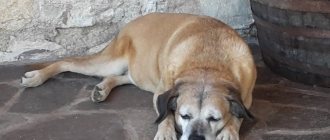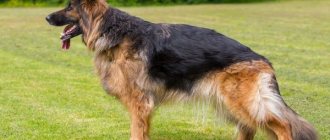Normally, dogs do not have formations, lumps or swelling in the nipple area. Their appearance should alert the owner and become a reason to visit a veterinarian. Most often, a lump appears near a dog’s nipple for the following reasons:
- cancerous tumors;
- benign tumors;
- mastitis;
- mastopathy.
Injuries and an overgrown tick head can also trigger the formation of seals. For these reasons, bumps appear not only in the nipple area, but also on any part of the animal’s body.
Mammary cancer
More often, malignant tumors are observed in older animals, but due to the unfavorable conditions of the city today, even young dogs with an insufficiently strong immune system cannot resist pathological changes in cells.
A feature of such neoplasms is rapid growth and rapid appearance of metastases. The tumor first appears near one nipple, but in a short time seals form in others located next to it. This is due to the fact that the nipple is not a separate mammary gland. The dog has only 2 mammary glands, which look like a ribbon with several nipples.
All malignant tumors affecting the mammary glands are divided into nodular and diffuse. The first category has clear boundaries and is not very large in size. Multiple formations may appear at once. This hard lump near the nipple in a dog develops for a relatively long time without metastasis, which is why the prognosis, if detected in a timely manner, is quite favorable.
In the diffuse form of cancer, the tumor is diffuse and has unclear boundaries. It grows quickly and to significant sizes. Due to the fact that pathological fluid accumulates around it, the resulting lump is soft. With this form the prognosis is unfavorable.
If the tumor is detected in a timely manner and a surgical operation is performed in which all pathological tissues are excised, then the prognosis for the pet is favorable with proper care and proper recovery.
Drug therapy
There are no special tablets or drugs that would completely eliminate a mammary gland tumor in a dog. How to treat the animal other than surgery will be decided by the veterinarian based on the examinations performed. As a rule, all the drugs used are very specific and expensive. Without a special purpose, no one will sell them anyway.
It is very difficult for a doctor if a malignant tumor penetrates deeply into the surrounding tissues, and sometimes grows through vital organs, which cannot be completely removed. In this case, the surgeon tries to clean the cavity as much as possible from tumor cells, after which long-term chemotherapy is prescribed. We emphasize that today we are considering a mammary tumor in a dog. Treatment of cancer of the intestine and other organs may follow a slightly different scenario.
So, chemotherapy can take a long time, and it is designed to prevent relapse of the disease. However, in an adult dog, only complete excision of the tumor gives a pronounced positive effect. And in this case, the body experiences enormous stress from the operation, which is subject to aggressive medication. The immune system weakens so much that it may simply not be able to resist cancer in the first stages of therapy. That is, the dog simply will not live to see the moment when it produces results. The approximate period when we can talk about successful treatment is 6.5 months.
Benign tumors
They account for about 40% of all mammary gland lumps in dogs. Such cones grow slowly, over several years, and do not cause discomfort to the animal. Dogs usually don't pay attention to them. The prognosis for the animal in such situations is favorable. With these neoplasms, in the vast majority of cases, a soft lump is found near the dog’s nipple.
It is advisable to remove benign tumors so that in an old dog they do not turn into a malignant form. Since this does not always happen, surgery is not necessary.
One, two, many
Those who have kept animals at home know well that their nipples are located along the entire surface of the abdomen. There are cases when single benign tumors of the mammary glands are observed in dogs. That is, one of the nipples turns into a hard ball that rolls under the fingers. But it does not grow and does not bother the pet in any way.
However, more often than not, approximately 40% of animals experience multiple tumor development. This process usually involves both rows of mammary glands. This may be accompanied by severe inflammation, and in some cases even necrosis. Is it possible to distinguish between a benign and a malignant tumor? The first is usually palpated in the form of a small ball, which is very mobile and rolls when palpated. Usually it has a smooth, regular shape. During the malignant course of the process, it attaches to the wall of the abdominal cavity, which an experienced doctor can also determine by palpation. Such tumors grow quickly and have an irregular shape. On the surface we see ulcerative lesions, redness of tissues, swelling of the extremities.
Approximately half of all cases treated at veterinary clinics are benign mammary tumors in dogs. These include complex adenomas and simple and papillomas. What to do with them will be decided by the veterinarian. It is better not to touch some formations; for the treatment of others, a course of special medications is prescribed. But the other half of the shaggy patients are those who are much less fortunate. They are diagnosed with osteogenic sarcomas, fibrosarcomas, cystic adenocarcinomas and other unpleasant neoplasms, which in some cases can be fatal.
Mastopathy
Although mastopathy is classified as a benign growth of the mammary gland, it is worth considering the pathology separately from benign tumors. With this disease, the animal experiences discomfort and sometimes pain. The disease occurs in dogs older than 6-7 years, when the first hormonal changes begin to occur in the body. The main localization of the growth is the 4th and 5th nipples.
Initially the tumor is single. If treatment is not carried out, multiple compactions form. The problem usually appears after estrus, pregnancy or false pregnancy. During these periods, there is a natural increase in the volume of the mammary glands, which after a certain period of time should return to normal. However, against the background of hormonal disorders, changes in tissues may occur, and then mastopathy will begin to develop.
To treat the disease in the initial stage, various homeopathic preparations and hormonal agents are used. They allow you to restrain the growth of formations for a long time. For many dogs, this treatment is sufficient.
If there is a risk of the tumor becoming malignant, or due to its large size it seriously compresses the internal organs, surgery is necessary. The prognosis after it depends on the condition of the animal.
Mastitis
Mastitis is the main cause of lumps in the nipple area of a puppy dog. The disease is associated with a violation of the outflow of milk and the formation of a milk plug, which creates favorable conditions for the growth of bacteria and the development of purulent inflammation. The lump is located near or under the nipple. This disease is the main one after the birth of puppies in a nursing dog.
The pathology is dangerous not only for the female, but also for the puppies, since infected milk easily leads to fatal poisoning. The main symptoms of the disease are:
- apathy;
- refusal to eat;
- visible swelling of the mammary gland in the area of one or more nipples;
- pain when touched, causing the dog to react aggressively to touching the nipples;
- redness in the affected area;
- when pressing a small amount of milk mixed with blood and pus.
Treatment should be carried out immediately. To restore the normal condition of the animal, antibacterial therapy, milking of stagnant milk and warm compresses are necessary.
In severe cases, if the disease is very advanced, surgical intervention is required, during which the suppuration will be opened and the cavity will be sanitized. Without treatment, the dog will die in 95% of cases.
Other reasons
Lumps in the nipple area in dogs can also occur for several other reasons.
When a lump is found near a dog's nipple,
It is urgent to show the animal to a veterinarian. This will allow you to accurately and timely determine the cause of the problem and provide quality therapy.
People can be very picky about their appearance, spending a lot of time in front of the mirror. Despite this, almost all dog breeders forget that cosmetic problems are not only the prerogative of humans. Similar troubles happen to our smaller brothers. In particular, comedones in dogs are quite typical. Despite their apparent “frivolity,” they can cause a lot of trouble for your pets.
Unlike humans and even cats, where comedones are actually clogged sebaceous glands, acne in dogs can “technically” be considered a manifestation of folliculitis and.
Inflammation of the hair follicle - folliculitis, transition of the process to a purulent form with the formation of pustules - furunculosis. Thus, in dogs this pathology is quite dangerous in itself. If you do not provide timely medical care to a sick dog, the consequences can be very serious.
Comendons “grow” in abundance on the chin and lips
.
Since these areas are covered with short and coarse hair, clinical signs quickly become apparent. Subsequently, the skin in these areas becomes inflamed, swells, and possibly (later) the formation of cicatricial adhesions. In most cases, quite severe skin itching develops, sometimes the dog scratches its face until it bleeds.
It is believed that comedones are quite common in all dog breeds.
But in practice, it turns out that more than 70% of cases are diagnosed in short-haired animals. In addition, it is in them that the disease is often most severe, often (and without much delay) progressing to.
Types of skin diseases in dogs
If there is the slightest change in the dog’s hair, contact a veterinary clinic to carry out the necessary tests and make an accurate diagnosis of the disease. Here are some common skin diseases in dogs. Only a doctor can make an accurate diagnosis.
Symptoms of the disease
If skin diseases appear in dogs,
symptoms are divided into 3 groups.
- Excruciating itching, in which the dog scratches the body until there are abrasions and scratches.
- The appearance of new growths on the skin: plaques of different sizes and colors, warts, blisters. On the damaged body of the dog, peeling and redness of the skin develops, which turns into baldness.
- If the damaged areas of the skin get infected or get microbes, the dog’s skin becomes inflamed, swollen and festers.
Skin diseases in dogs are dangerous for animals and humans. It is important to provide timely medical care to your pet.
Further development of the disease
If you don't take your dog to the vet, things will get much worse:
- Small ulcers and boils burst, the chin area is sometimes completely covered with drying pus and ichor.
- As the animal’s immunity weakens, increasingly larger papules and boils appear.
- Bursted boils and papules do not heal; large ulcers develop in their place.
- Due to pain and intoxication, the animal partially or completely loses its appetite.
Predisposing factors
Unfortunately, there are many dozens (if not hundreds) of causes of comedones in dogs. That is why the primary task of the treating veterinarian is to identify a specific factor in a particular case:
- Injuries.
- . By the way, this is a very common reason.
- Autoimmune diseases.
- Eosinophilic folliculitis and furunculosis.
- Malassezia dermatitis.
- Histiocytosis.
- Metabolic disorders. Let us note that comedones often appear in those dogs whose owners do not particularly monitor the quality of their pets’ diet.
- Neoplasia.
- reactions.
- Secondary staphylococcal
skin lesions. They usually develop against the background of various injuries, accompanied by a violation of the integrity of the skin.
Previously, it was believed that acne in dogs is almost always the result of hormonal imbalances in the pet’s body. But now experts are inclined to believe that it’s all about pathological follicular keratinization, which is characteristic of most shorthaired pores
od. But even among them there are varieties that are at particularly high risk.
Foreign pigmentation on the body of the animal causes concern for the owners. There are several reasons for this phenomenon, from completely harmless to dangerous to the pet’s health.
If you cannot determine the cause on your own, it is better to contact a specialist.
Prevention
To prevent the appearance of black spots on the skin of dogs, it is necessary to provide the pet with proper care, regular but not excessive washing: no more than once every 5 months for dogs with fur and once every 2 weeks for hairless ones. It is also important to provide the animal with adequate nutrition and sufficient exposure to fresh air.
When purchasing clothes for dogs, you need to carefully determine the size so that the overalls do not pinch or rub the skin. Knowing why black spots appear on a dog's body ,
the owner will be able to prevent the problem from occurring or, if it already exists, provide quality treatment.
Foreign pigmentation on the body of the animal causes concern for the owners. There are several reasons for this phenomenon, from completely harmless to dangerous to the pet’s health.
If you cannot determine the cause on your own, it is better to contact a specialist.
Common causes of blackheads
These include conditions and diseases:
- Lentigo.
- Dermatophytosis.
- Weeping dermatitis.
- Comedones.
- Demodecosis.
- Seborrhea.
- Hormonal disorders.
A black dot on the skin that does not cause other symptoms is a common comedon. This is a time clogged with dirt and sebum. It occurs in dogs with little hair on exposed areas of the body due to extreme heat and lack of hygiene. Only in miniature schnauzers primary comedones are the norm and do not require intervention.
For other breeds, skin care is provided, scrubs are done and nutrition is monitored. Often comedones are caused by hormonal disorders. Additionally, this condition is accompanied by increased greasiness, unpleasant odor, spots and baldness. A sharp jump in hormones is typical for older dogs.
A cosmetic defect includes lentigo - characteristic dark spots on the skin and paws. Unfortunately, there is no cure for it. Normally, it does not interfere with the life and health of the pet in any way.
Black spots on the back are a sign of infection
Bacterial pathogens and fungi provoke dermatitis and dermatophytosis. The infection enters the body through micro-wounds on the body. Symptomatization occurs against the background of reduced immunity. These pathogens constantly live on the skin, but are dangerous only for weakened pets.
These infections cause:
- itching inflammation;
- crusts;
- wet marks;
- baldness.
The pet itself feels discomfort and, when scratching, spreads lesions throughout the body.
How to treat black spots on the body
Before prescribing treatment, the veterinarian does a bacterial culture. This helps to identify the cause and prescribe an effective and safe drug:
Infections are fought with antibiotics, and external manifestations are stopped with antibacterial ointments and healing medications. During the treatment period, maintain sanitary conditions and prevent dirt from getting into the wounds.
If blackheads appear due to allergies, then a set of actions to relieve them is developed.
Cosmetic defects are not eliminated. To avoid infectious diseases, you need to carry out preventive measures on time and properly care for your pet. It is important to monitor immunity and nutrition, give vitamins and ensure an active lifestyle.
One of the most common postpartum complications is mastitis. Mastitis is an inflammation of the mammary glands that develops both in lactating bitches and in dogs with false pregnancy. But why does this pathology develop, and how does it manifest itself? How to cure a dog?
Treatment of skin diseases
Selected simple diseases of dogs and skin diseases can be cured at home.
The home flower, aloe, has healing properties. Aloe juice applied to the dog's damaged skin will relieve itching, discomfort and burning sensation. It’s easy to squeeze aloe juice yourself or buy a ready-made product at the pharmacy.
Herbal decoctions have similar effects: chamomile, calendula, echinacea. The drugs reduce pain in the dog, relieve inflammation and eliminate microbial suppuration on the skin.
These drugs are used exclusively in the initial stages of the disease. If complex skin diseases are observed in dogs, treatment is carried out in a veterinary clinic. Before prescribing medications, the doctor is obliged to conduct a full diagnosis of the suspected disease, take appropriate skin tests and blood tests, and remove scrapings from the dog’s skin. After determining the exact diagnosis of the disease, effective treatment is prescribed.
An accurate diagnosis of the disease cannot be made solely by visual examination. It will be necessary to conduct laboratory tests on the dog's hair.
If a doctor, after looking at a dog, immediately prescribes medications, the dog cannot be treated under the guidance of such a doctor. Remember, improper treatment can lead to the death of the animal.
Preventive measures
Dog diseases are often associated with improper maintenance and care. It is necessary to fulfill simple conditions so that the pet remains healthy and alert.
Don't let your four-legged friend suffer, remain a responsible owner.
Diseases of dogs (non-contagious) Panysheva Lidiya Vasilievna
Diseases of the nipples and mammary glands
The female mammary gland consists of ten lobes located on the abdominal and chest walls on the sides of the white line of the abdomen. The milk ducts open at the tip of the nipple with 6–12 openings.
Cracked nipples
. Cracks usually appear during sucking and can be either superficial or deep.
The reasons for the formation of cracks are the dirty content of the nipples and poor milk production of the mother, in which the puppies suck a lot and sometimes bite the nipples.
The affected nipples become inflamed, the cracks are covered with bloody or purulent crusts. When ulcers form, their bottoms have a greasy appearance.
Treatment
cracks that appear due to insufficient milk production, comes down to artificial feeding of the puppies, which must be placed with the mother only for the suckling period. If the puppies will not be removed from their mother, then all nipples must be covered with a blanket, which must be removed for the feeding period. After feeding, each nipple is treated with a one percent solution of methylene blue in 60° wine alcohol or a solution of penicillin (10,000 units of penicillin in 1 ml of physiological solution), or the nipples are sprinkled with white streptocide powder.
Neoplasms on the nipples
. Fibroids are the most common neoplasm on the nipples. Their consistency is quite dense; skin ulcerations usually do not occur. The nipple may be retracted and the tumor will develop a long stalk (Fig. 145).
Rice. 145. Nipple fibroma
Treatment
comes down to removing the tumor after preliminary infiltration anesthesia of the leg, which is cut circularly. Bleeding from damaged vessels is stopped by torsion or ligation with a catgut ligature. Several stitches of interrupted suture are applied to the edges of the skin wound.
Inflammation of the mammary gland
. Inflammation of the mammary gland (mastitis) is common in bitches. The main form is purulent mastitis. It develops due to the penetration of microflora (streptococci or staphylococci) through the nipple canals or hematogenously.
Mastitis is accompanied by an increase in local temperature, redness of the skin (if the skin is not pigmented), enlargement and soreness of the affected lobe. The milk is watery with an admixture of flakes, and later acquires a yellowish color. The animal shows signs of general depression (loss of appetite, increased heart rate and breathing). Body temperature rises significantly.
During treatment
Massaging and rubbing ointments is contraindicated, as this contributes to the spread of infection to other lobes of the gland. Poultices, compresses, heating pads, and paraffin applications have a good effect. The best types of treatment, tested in practice, are: novocaine blockade of the mammary gland and penicillin therapy. Of the various types of novocaine blockades in the treatment of mastitis, the short one is very effective, which consists of introducing 80.0–100.0 ml of a 0.25% novocaine solution between the abdominal wall and the base of the mammary gland. The needle is inserted from the outside of the breast. If necessary, the blockade is repeated after 3–4 days.
Penicillin is administered intramuscularly or subcutaneously (200,000 units dissolved in 5.0–10.0 ml of 0.25% novocaine solution) 2–3 times a day. The effectiveness of penicillin therapy is very high in acute mastitis. When an abscess forms, it is opened.
Rice. 146. Mixed breast cancer
Neoplasms in the mammary gland
. Benign tumors sometimes develop in the mammary gland of dogs, but malignant ones are also often found. The most common malignant tumors are carcinomas (cancerous), which usually appear in dogs from 8–9 years of age and in some cases are not isolated. Cancer tumors in most cases are mixed (for example, fibro-chondro-adenocarcinoma), and they sometimes reach enormous sizes (Fig. 146). Of the 68 dogs we operated on, 62 of them had mixed cancerous tumors and only six had sarcomas and benign neoplasms. These tumors usually have a dense consistency, sometimes some areas of them undergo disintegration, involving the corresponding areas of the skin (Fig. 147). On a section, such tumors have a pale gray color, reminiscent of the color of lard (Fig. 148). When examining a sick animal, it is necessary to carefully palpate all lobes of the gland. Tumor metastases are compacted formations the size of a small pea to a walnut or larger.
Rice. 147. Disintegrating cancerous tumor removed from a dog's mammary gland
Treatment
consists of removing (extirpation) the tumor and all metastatic and suspicious areas. When the caudal lobes of the gland are affected, sacral anesthesia is usually used (see the surgery section), while operations on other lobes are performed under local infiltration anesthesia by infiltration with a 0.25% novocaine solution.
Rice. 148. Cross-section of a mixed breast cancer tumor
The animal is placed in a dorsal position. The affected lobe of the mammary gland is pulled away from the abdominal wall and 4–6 points are marked around its base, into which the solution is alternately injected with a thin needle, infiltrating the skin and subcutaneous tissue around the gland. These injections require 30–100 ml of solution. Then the injection of the same amount of solution is repeated at the same points, and now the thoraco-abdominal fascia is pierced with a needle and all the fiber at the base of the gland is completely soaked. As a result of injections, the iron rises, being pushed away from the abdominal wall by the solution (Fig. 149). After this, tissue dissection begins.
Rice. 149. Infiltration under the base of the mammary gland lobe of a dog affected by a tumor
An ellipsoidal incision is made around the circumference of the tumor. If there are fistulas or ulcers, they are covered with gauze. Subsequent dissection is carried out using the so-called blunt method using a gauze compress or scissors. In the swollen tissue, the vessels are clearly visible, which creates favorable conditions for dressing. The preparation of the affected parts of the gland is facilitated by the fact that the solution itself separates the affected parts from the healthy ones, which is very important when extirpating malignant tumors, which should be separated only within healthy tissues. All existing metastases must also be removed from the mammary gland. Metastases located outside the main site of the lesion, due to the large amount of anesthetic solution injected around them, always become noticeable and cannot be bypassed by the surgeon. The operation is completed by applying an interrupted suture to the edges of the wound, and a bandage made of a protective blanket on top.
From the author's book
Breast injuries Give Arnica or Bellis perennis immediately after injury; if post-traumatic inflammation develops in the future, consider prescribing Conium or Phytolacca (see above for descriptions of these
From the author's book
Diseases of the thyroid gland Treatment of diseases of the thyroid gland, as well as diseases of the liver and heart, should undoubtedly be entrusted only to a professional homeopathic veterinarian, since in all these cases the condition of the animals can be quite severe and
From the author's book
Thyroid hormones The main hormones of the thyroid gland are thyroxine (tetraiodothyronine, T4) and triiodothyronine (T3), which are iodinated derivatives of tyrosine. Biological action. Target cells of iodothyronines have 2 types of receptors: 1. intracellular
From the author's book
Pancreatic hormones The pancreas is a mixed secretion gland. The endocrine part of the pancreas is a collection of islets of Langerhans (1–2% of the total volume of the gland). In the islets there are several types of endocrine cells that synthesize
From the author's book
Chapter 10. TUMORS OF THE BREAST AND GENITAL ORGANS Tumors, or neoplasms, neoplasms, are pathological growths of tissues consisting of qualitatively changed cells that have completely or partially lost their shape, function and other characteristics.
From the author's book
10.1. TUMORS OF THE MASTY GLAND (TUM) TUMORS are very common in dogs and account for 32% of all neoplastic lesions (Schneider R., 1980). Skin neoplasms are the second most common after AMF in dogs. The cause of AMF is unknown. Wide circle
From the author's book
Diseases of the thyroid gland The thyroid gland belongs to the closed glands, that is, without an excretory duct; its waste products are transmitted to the body through the blood. The activity of these internal secretion organs (thyroid gland, parathyroid,
From the author's book
Basic hormones and glands Data obtained in recent years suggest that the endocrine system permeates almost the entire human body. Cells that secrete hormones are found in almost every organ. Thus, hormones of the heart, kidneys, lungs and
From the author's book
Inflammation of the anal gland Inflammation and swelling of the anal gland is a common disease that causes anxiety for dogs. She becomes lethargic, refuses to feed, and has difficulty bowel movements. The dog tries to “ride on its buttocks,” which is very often perceived
From the author's book
Inflammation of the mammary gland (mastitis) Inflammation of the mammary gland, or mastitis, occurs quite often. As a rule, mastitis is preceded by cracked nipples, which become inflamed due to the penetration of microflora. Then the inflammation spreads to the entire breast
From the author's book
Adenoma of the third eyelid gland Adenoma of the third eyelid gland, or “cherry eye,” is a hyperplastic adenomatosis of the third eyelid gland, which is located on its inner side. The disease is more common in young dogs under one year of age. In addition to
From the author's book
Cyst of the sublingual gland ¦ ETIOLOGY Formed as a result of inflammatory processes and traumatic injuries, as well as due to blockage of the excretory ducts with small salivary stones. ¦ SYMPTOMS Presence of a small tumor in the submandibular space. Upon examination
From the author's book
Glands of the oral cavity In the process of their development, terrestrial animals arose the need to moisturize the mucous membrane of the oral cavity and solid food masses. For this reason, a number of glands arose that began to produce a special secretion - saliva, satisfying
From the author's book
Teeth, glands and feathers The appearance of teeth not only marked the beginning of a new way of existence, but also opened a new way for the development of organs. Teeth develop through the interaction of two layers of tissue in our skin. This process is based on the contact of these layers,
Oncological diseases are becoming more common. And, unfortunately, not only in humans. Our smaller brothers are no less susceptible to this terrible disease. Veterinarians note that over the past twenty years, the number of animals with tumors of various natures and sizes has increased at least five times. Perhaps previously they were simply not brought to the clinic, and the dogs lived out the time allotted to them without medical care. Be that as it may, today we have a chance to help our pets, and we need to use it.
Causes of mastitis
- Lactostasis is stagnation of milk. Due to the fact that the secretion of the mammary glands is not removed, it begins to compress the alveolar tissue, causing its irritation. Milk is an ideal environment for the proliferation of bacteria and fungi, so when it stagnates, microorganisms actively increase in number, leading to the development of inflammation. Lactostasis occurs due to the fact that puppies do not eat all the milk produced (little or complete absence of puppies, false pregnancy).
- Wounds, cracks in the skin of the mammary glands - all this is an additional gateway for infection. Bacteria and fungi penetrate the alveolar tissue and the circulatory system through damage to the skin. That is why it is important to ensure that puppies do not scratch the mammary glands of the nursing bitch during feeding (after all, babies “trample” the gland with their paws to stimulate the production of milk).
- Other inflammatory processes in the body, intoxication. For example, if the bitch had endometritis (inflammation of the uterus), dead puppies remained in the uterus for a long time, problems with internal organs. Bacteria quickly spread through the bloodstream throughout the body, but in order to form milk, a huge amount of blood must pass through the mammary gland. This is how infection of the alveolar tissue occurs.
- Blockage of the milk duct. It is very similar to lactostasis, only with it milk is either not removed by the puppies at all, or in insufficient quantities, or is formed too quickly. If the nipple canal is blocked, it cannot be removed from the mammary gland at all.
- Overheating or hypothermia of the animal. It is very important that the lactating bitch has comfortable living conditions.
- Exposure to the mammary gland of aggressive chemicals.
- Stress. It doesn't benefit anyone. Due to the pet's nervous overstrain, the owner may notice how the dog's mammary glands are swollen: mastitis develops.
- Genetic predisposition. Even at the gene level, there may be a tendency to develop an inflammatory process. Therefore, if you know the facts that your beauty has had inflammation of the mammary glands in her family, it is better to sterilize your pet so that she does not suffer from mastitis.
- Poor living conditions, dirt on the bed. The dog itself may be dirty. Always keep your pet's mammary glands and nipples clean. If necessary, rinse with warm water.
- Endocrine diseases. Problems with hormones always provoke deterioration in health. Metabolism is disrupted, organs function worse, hair begins to fade and fall out.
Dark nipple problem
Age-related changes can provoke darkening of the nipples on a woman’s breast. Puberty in teenage girls can cause nipples to become dark in color. The same thing can happen to women during menopause.
The reason that the nipples have become dark may be breastfeeding. Against the background of hormonal surges, a nursing mother's nipples may change color. The phenomenon can also be caused by improper attachment of the baby to the breast. Ignorance of the rules of application can provoke not only a change in the color of the skin on the nipples, but also the formation of cracks.
If changes in nipple color are not associated with any of the above reasons, a woman should consult a mammologist. The reasons for the color change may be diseases of the mammary glands.
Darkening of the nipples during pregnancy
There are different reasons for nipple discoloration, but the most common is pregnancy. Many women guess their interesting situation precisely by this sign. To dispel doubts, just do a test.
There is nothing wrong with the fact that during pregnancy some representatives of the fairer sex have darker nipples. The explanation for the phenomenon lies in physiological changes in hormonal levels. According to statistics, it is in the fifth week that the nipples turn brown, even if the nipple was previously soft pink. This is due to a sharp increase in melanin production. The color of the nipples depends on the color of the hair, eyes and skin. Why are nipples more likely to darken on a brown-eyed brunette than on a blue-eyed blonde? The fact is that the level of melanin in dark-haired girls is initially higher.
Along with darkening of the nipples during pregnancy, other areas of the body may become stained: the stomach, face and even genitals, but this is not clear. Pigmentation in pregnant women is very
Mastitis is an acute or chronic inflammation of the mammary gland. Most often, mastitis in dogs is recorded in the postpartum period or in the presence of a false pregnancy, when the dog’s mammary glands intensively secrete milk. Of the microbial associations, the main causative agents of mastitis are staphylococci and streptococci.
The immediate causes of mastitis in dogs are:
- Injuries to the mammary gland , often caused by the claws of hungry puppies during sucking, as a result of which a bacterial infection penetrates into the wounds, leading to inflammation.
- Stagnation of milk in the mammary gland (so-called stagnant mastitis), caused by the accumulation of unsucked milk in the dog’s udder during the birth of a dead litter, early incorrect weaning of puppies from their mother, and with intensive lactation in the bitch.
- Postpartum infection and intoxication of the body in the presence of emphysematous fetuses in the uterus, retained fetuses, postpartum endometritis, as well as diseases of the gastrointestinal tract.
- False pregnancy (usually 2 months after estrus).
- Blockage of the nipple sphincter duct.
Mastitis in dogs can occur from high and low temperatures , exposure to chemicals , and as a result of stress. A large role in the occurrence of mastitis in dogs is played by a hereditary predisposition to this disease.
The inflammatory process in the mammary gland in dogs most often occurs in the form of catarrhal or purulent mastitis , involving one or more mammary gland bags in the process.
Symptoms. In a sick dog, we note lethargy, decreased or lack of appetite. The affected packages of the mammary glands are visually enlarged in size , upon palpation they are dense, painful and hot to the touch, their skin is reddened (if the skin is not pigmented). watery milk mixed with greenish-brown or gray-white flakes is released from them during catarrhal mastitis For purulent mastitis - a small amount, sometimes a few drops of yellowish or yellowish-brown liquid or a thick gray mass, often mixed with blood . In the absence of timely qualified veterinary care, catarrhal and purulent mastitis can develop into an abscess, in which abscesses spontaneously open and dark gray purulent contents with scraps of necrotic tissue are released from the resulting fistula, and subsequently into phlegmon and gangrene of the udder.
Types of mastitis
Mastitis is classified according to its course: acute and chronic. In acute cases, inflammation develops very quickly, but it is easier to cure a dog with this form. Chronic mastitis is sluggish, the symptoms are more blurred, the mammary gland “degenerates,” and therapy is protracted and not always effective.
Inflammation of the mammary glands is also classified according to the nature of the exudate: pus, fibrin or mucus (catarrh). That is, most often dogs have purulent or catarrhal mastitis (often mixed with blood).
However, there are also serous (external changes in milk are extremely difficult to notice), fibrinous (in the secretion of the glands you can find dense white strands - fibrin threads), phlegmonous (the same purulent, only the pus is in the subcutaneous tissue, as if spilling), abscess (in the inflamed lobes, abscesses appear - ulcers surrounded by connective tissue, like a capsule) and gangrenous (the tissues of the glands “die off”, turn black).
Symptoms of mastitis in dogs
- One of the obvious symptoms that a pet has mastitis is a swollen mammary gland in the dog. And if you touch the milk carton, it is hot, dense, and extremely painful. With lactostasis, the skin temperature on the swollen bag is low, but the overall body temperature rises significantly above normal.
- Increased body temperature. Mastitis is an inflammation, and it is always accompanied by fever. In addition, there is severe thirst, lethargy and extremely poor appetite.
- Soreness and redness. Again, there are clear signs of an inflammatory process in the animal’s body. An inflamed milk bag will be noticeably red, swollen, painful and hard.
- The secretion of the mammary gland changes. Milk does not always noticeably change its consistency (with serous mastitis), however, with gentle pressure, milk of a yellowish, yellow-green color with pieces of pus or admixtures of blood will be released from the nipple. Purulent mastitis is dangerous because microorganisms quickly spread through the bloodstream throughout the body, and pus can provoke sepsis. With catarrhal mastitis, the milk acquires a watery consistency, in which you can see flakes of a grayish-yellow color (sometimes brown).
Abscesses and phlegmon of milk bags are extremely dangerous, because they are purulent foci that can lead to sepsis and gangrene of the gland. The animal dies due to intoxication.
Veterinary care for inflammation of the mammary gland
- To increase the overall resistance of the body: Fosprenil
(intramuscular 0.2 ml/kg body weight 2-4 times a day for 5-7 days; it is important not to miss each subsequent injection),
Immunofan
(subcutaneous or intramuscular 1 ml/animal, once a day within 3-5 days). - Intramuscularly or subcutaneously Mastomethrin
(1-4 ml/dog, depending on size, 1-2 times/day until the symptoms go away) or
Travmatin
, if pain syndrome is severe (0.1 ml/kg body weight subcutaneously or in muscle up to 2 times a day for 3-5 days). - Antibiotics: amoxicillin 15%
(into the muscle 1 ml/10 kg of dog weight once, course 5-7 days),
ceftriaxone
(into the vein or muscle 20-40 mg/kg per day - the dose can be divided into 2 injections, course: 5 -10 days),
enrofloxacin 50
(intramuscular 1 ml/10 kg once for 5-10 days, the injection is painful, it is important not to miss a dose). - Local creams and ointments for mastitis: “Zorka” cream
(smear the nipples 1-2 times a day after washing),
DE cream-emulsion
(apply a very thin layer 2-3 times a day to the affected lobe of the gland, without touching the nipple; course up to 1 week),
De-Long cream-emulsion
(applied to the inflamed mammary lobe, covering healthy areas without signs of damage and compaction up to 3 times a day for 5-7 days; in special cases, injected directly into the mammary gland through nipple using a milk catheter for dogs),
Phytoelita Antiseptic cream-balm
(applied to areas of inflammation and seals under a bandage once a day, changing the bandage every day, and after 3-5 days - every other day. Course - 2 weeks). - Short novocaine blockades. Novocaine 0.5%
is injected at a dose of 5-20 ml (depending on the size of the dog) into the space between the affected mammary gland and the peritoneal wall. If necessary, repeat the procedure after 1, 2 or 3 days. - Surgical treatment of mastitis in dogs is indicated in especially severe cases. Abscesses are opened, the purulent wound surface is cleaned, and drains are installed to drain the inflammatory fluid. In severe cases, the gland is removed (mastectomy), either part or all.
Treatment of a dog with mastitis
If you notice that your dog's mammary gland is swollen, do not try to start treatment yourself. Both lactostasis and mastitis should only be dealt with by a veterinarian. You should not try to alleviate the animal’s condition at home without qualified veterinary care. And in any case, puppies are transferred to artificial feeding, otherwise they will begin to have problems with digestion (bacteria in milk are dangerous for a fragile puppy’s body).
It will be almost impossible to cure your pet without antibiotics, but therapy must be comprehensive. We need drugs that improve the outflow of exudate. And antibiotics are ideally selected based on titration results. It is necessary to conduct a bacteriological study of milk from the affected lobe, isolate the pathogen, and determine its sensitivity to antibiotics of various groups.
In the initial stages, good results can be achieved with physiotherapy (two to five sessions are required). But you shouldn't try to make them at home yourself. Massages and heating during purulent inflammation are prohibited, as they lead to pus entering the blood and surrounding tissues.
Also, at the initial stage, it is possible to achieve good results thanks to the novocaine blockade. It would be a good idea to learn how to properly express milk from the affected lobe in order to remove microorganisms and the ideal environment for their reproduction - milk - from the inflamed bag.
In addition, pumping will reduce pressure on damaged alveolar tissue and reduce pain. However, it is worth remembering that after expressing the milk comes again, so you will have to carry out this procedure repeatedly or immediately after emptying the gland, bandage it tightly.
If physiotherapy does not help, the veterinarian will prescribe antibiotic therapy and vitamin therapy. In more complex cases, surgical intervention is also necessary. The pustules are opened, washed and covered with powdered antibiotics.
Treatment
When is self-help at home acceptable?
Treatment of mastitis at home can be done only in mild forms and non-purulent course. In all other cases, self-medication is unjustified and can have serious consequences. In any case, a specialist will advise you in detail on what to do if your dog has mastitis.
Action with puppies during mastitis treatment
Puppies can only be allowed to see a sick mother if they have serous and catarrhal forms. In these cases, they will help alleviate the condition of the nursing bitch. As soon as purulent, purulent-catarrhal or fibrinous forms are detected and pus or fibrin is detected in the milk, the puppies are weaned and transferred to artificial feeding. Contaminated milk can poison the offspring and lead to its death!
What happens if mastitis is not treated or treated incorrectly?
In case of prolonged (chronic) inflammation of the mammary gland and improper treatment (or refusal), the following consequences are possible:
- degeneration of glandular tissues with the formation of tumors (both benign and malignant);
- loss of secretory function and forced removal of the gland;
- death of the pet from general intoxication of the body;
- death of the offspring from poisoning with milk contaminated with bacteria.
Prevention of mastitis
- What needs to be done to prevent the dog’s mammary gland from becoming swollen and developing lactostasis and mastitis? First of all, after whelping, take your pet to the veterinarian. He must check that the animal does not have postpartum complications. Indeed, due to hidden inflammatory processes, mastitis can develop.
- Be sure to clean the bed, the nurse’s resting place. Wash her tummy, milk bags and nipples. Make sure there are no wounds or cracks on them. If you find it, process it immediately and observe.
- Trim puppies' nails. These little ones have claws like needles - very sharp. Therefore, babies can scratch a nursing bitch, thereby opening the gates of infection.
- If the bitch has had stillborn puppies, then you need to see a veterinarian. Antibiotic therapy will probably be prescribed to avoid inflammatory processes in the body, and detoxification.
- If the dog had false pregnancy or a large influx of milk that the puppies cannot cope with (either there are too few of them, or none at all, or they eat little), then you need to think about suppressing lactation. If it is easier with false puppies (special medications are given, the glands are tightly ligated), then in the presence of puppies such methods are not suitable. Review your diet, remove all dairy products (this includes soups, liquid cereals, dairy products, wet food and meat), reduce the amount of liquid consumed.
- Don't forget about your hygiene. Your dirty hands or clothes can lead to inflammation, because after feeding the puppies, the nipple canal will remain open for another half hour to an hour. And bacteria from your hands will easily penetrate the gland.
- Don’t forget about washing the floors, just watch what you use. Remember that household chemicals will also harm your dog’s health.

